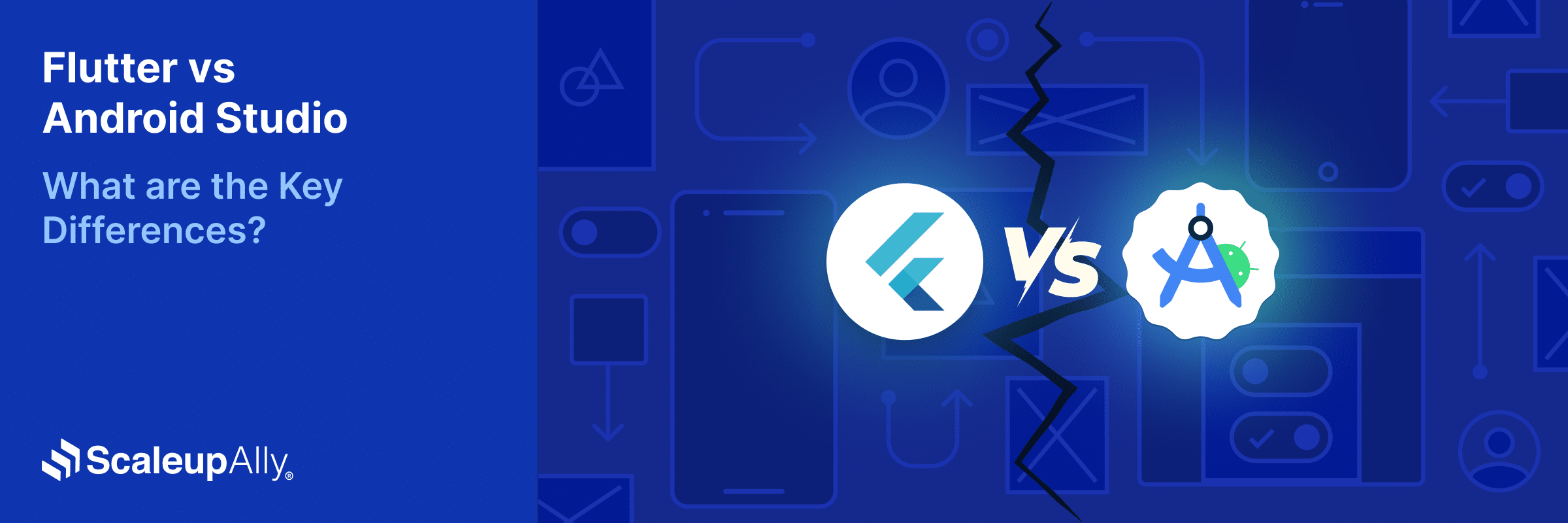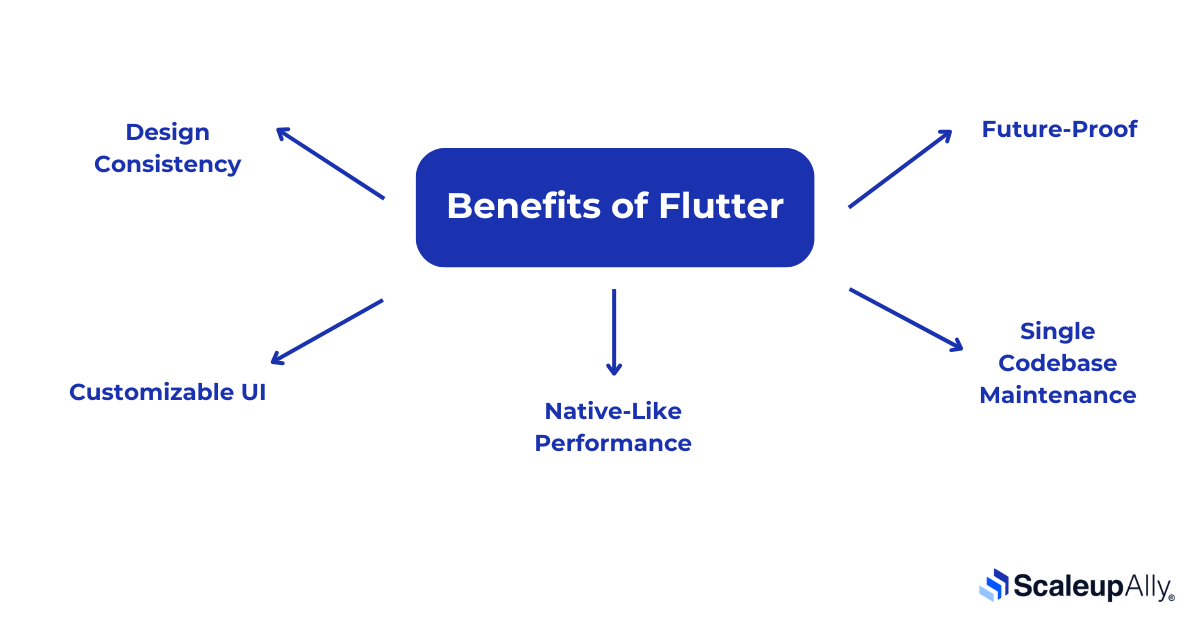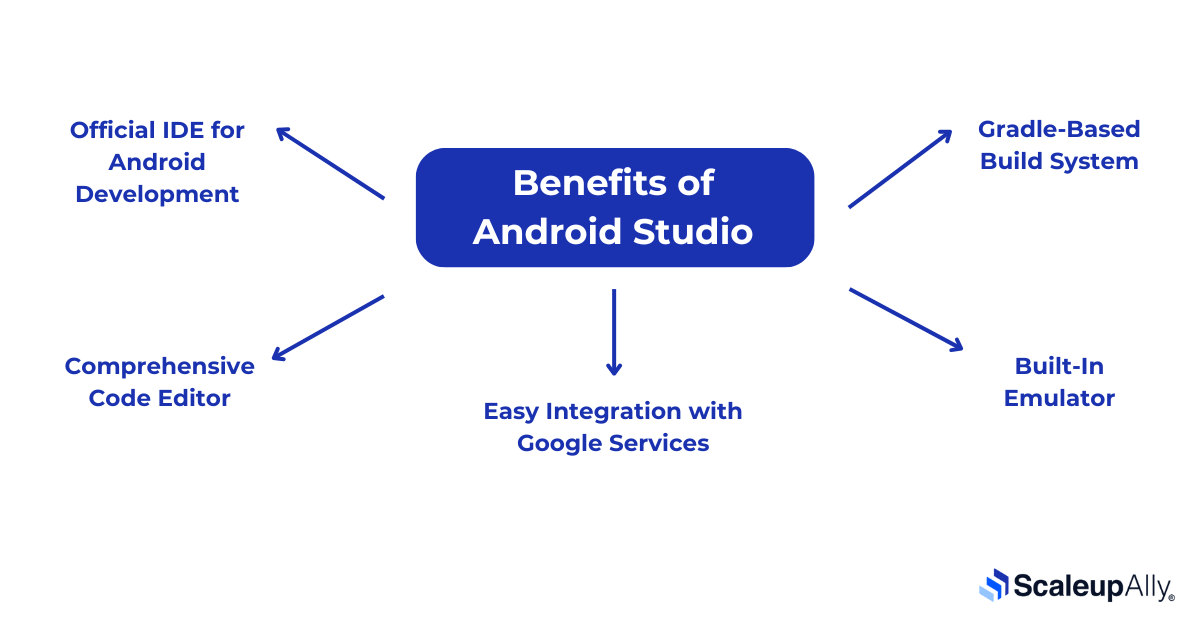
Flutter vs Android Studio: What are the Key Differences?
Suprabhat Sen | June 28, 2025 , 14 min read
Table Of Content
Anticipated to generate $522.67 billion dollars in revenue by 2025, mobile apps are poised to redefine digital commerce. Choosing the right development tool is essential. In this guide, we compare Flutter and Android Studio, two powerful tools from Google.
Key Takeaways
- Flutter is a cross-platform UI toolkit ideal for building apps across Android, iOS, web, and desktop from a single codebase.
- Android Studio is the official IDE for native Android development with advanced debugging, testing, and performance tools.
- Choose Flutter for cost-effective cross-platform development; choose Android Studio for robust, Android-focused projects.
Flutter Vs Android Studio: Differences at Glance
- Flutter Vs Android Studio: Differences at Glance
- What is Flutter?
- What is Android Studio?
- What are the key differences between Flutter and Android Studio?
- Which one is right for you, Flutter or Android Studio?
- Is Flutter better than Android Studio?
- Can I use Android Studio for Flutter?
- Conclusion
- Frequently Asked Questions
- Similar Comparison Articles Around Flutter
| Aspects | Android Studio | Flutter |
|---|---|---|
| Release Date | 2013 | 2017 |
| Backed By | Developed and maintained by Google | Developed and maintained by Google |
| Focus | Native Android app development | Cross-platform mobile app development |
| Languages | Kotlin and Java | Dart |
| Design Approach | Native Android design elements | Material Design & Cupertino styles for versatile UI |
| Development Speed | Known for native Android app functionality | Rapid development via Hot Reload, ensuring quick bug fixing |
| Adoption & Use Cases | Utilized by tech giants for Android-specific apps | Increasingly chosen for cross-platform app development and UI consistency |
| Suitability | Ideal for Android-centric projects with platform-specific optimizations | Suited for projects needing consistent UI across multiple platforms |
| Efficiency | High performance with Skia rendering engine. Hot reload for rapid development. | Powerful IDE with code completion, debugging, and profiling. Can be resource-intensive. |
| Cost-effectiveness | Free and Open Source. However, it has a one time developer’s license fee. | Free and Open Source. It saves cost due to its single codebase utility for both Android & iOS applications. |
| Scalability | Highly scalable for Android projects. Supports scalable projects but requires additional setup for cross-platform. | Designed for complex and scalable applications. Growing ecosystem with many packages. |
| Layout | Primarily uses XML layouts, which are easy to design but can become complex for dynamic layouts. | Uses a declarative UI framework with widgets to create flexible and dynamic layouts. |
| Realtime Changes | Instant Run allows real-time code changes but can be slow for large changes. | Hot Reload allows immediate updates to the app without restarting, speeding up the development process. |
Decision Tree: Which One to Pick?
Q1: Need cross-platform? → Choose Flutter
Q2: Focused on Android only? → Use Android Studio
Q3: Want quick development? → Flutter
Q4: Require advanced debugging? → Android Studio
For businesses focusing on Android-only projects, partnering with an experienced Android app development company ensures high performance and an optimized user experience.
What is Flutter?
Flutter stands as a modern, open-source UI software development kit introduced by Google. It functions as a powerful tool for developers, enabling the creation of cross-platform applications from a single codebase.
This unique capability empowers developers to design apps compatible with web browsers, Android, iOS, Linux, macOS, and Windows, all stemming from a unified codebase. Flutter emerged in 2015 and was officially launched by Google in May 2017.
Factors Contributing to Flutter’s Popularity
- Widespread Adoption: Over 700,000 apps in the Play Store are built with Flutter, with one in five new apps on the platform utilizing this framework, surpassing all other cross-platform frameworks combined.
- Dart Programming Language: Flutter’s use of the Dart programming language, equipped with advanced features, ensures robust app development, contributing significantly to performance and adaptability.
Unique Features of Flutter
- Widget-Based Architecture: Flutter boasts two sets of widgets, Material Design widgets and Cupertino widgets, tailored to specific design languages. This flexibility enables developers to interchangeably use widgets across platforms, ensuring design consistency.
- High-Performance Rendering: Flutter’s core concept revolves around rendering consistently
- Cross-Platform Compatibility: Flutter’s ability to build apps for various platforms from a single codebase simplifies development and maintenance, reducing time and effort for developers.
- Hot Reload for Faster Development: The Hot Reload feature allows one to instantly see changes are made in the code, making it easier to iterate quickly, fix bugs, and experiment with UI design without losing progress.
Versatility and Flexibility
- Cross-Platform Compatibility: Flutter’s ability to build apps for various platforms from a single codebase simplifies development and maintenance, reducing time and effort for developers.
- Design Consistency: The flexibility to utilize different design languages across platforms allows developers to maintain visual uniformity, enhancing the user experience across diverse devices.
Benefits of Flutter

- Design Consistency: The flexibility to utilize different design languages across platforms allows developers to maintain visual uniformity, enhancing the user experience across diverse devices.
- Customizable UI: Flutter offers a wide range of pre-designed widgets and powerful tools to create beautiful, customized, and highly interactive UIs.
- Native-Like Performance: Flutter apps compile to native ARM code, ensuring high performance and smooth animations, delivering a native-like experience across platforms.
- Single Codebase Maintenance: Maintaining one codebase for both platforms simplifies updates, bug fixes, and feature enhancements, making ongoing app maintenance easier and less costly.
- Future-Proof: Backed by Google, Flutter has strong backing for long-term support, ensuring ongoing updates, improvements, and scalability.
Limitations of Flutter
Flutter, while powerful, has a few limitations such as:
- App Size: Flutter apps can be large, which may pose challenges for users with limited device storage.
- Native Support: Some native features may not be directly supported by Flutter, necessitating reliance on third-party plugins that may not always be reliable or up-to-date.
- Performance: While generally performant, complex animations or intensive computations might impact performance.
- Language and Community: Dart, Flutter’s programming language, has a smaller developer community compared to Java or Kotlin, potentially limiting available resources and support.
- Native Modules Integration: Integrating with native modules can be complex, especially for developers not familiar with platform-specific code.
When to use Flutter?
Use Flutter if:
- You need to build once and deploy everywhere (iOS, Android, web, desktop).
- You want faster time-to-market and lower development cost.
- Your project requires custom UI and consistent design.
What is Android Studio?
Android Studio is the official Integrated Development Environment (IDE) for Android, the most popular operating system worldwide, with over 3 billion active users and a dominating market share in countries like Brazil, India, Indonesia, Iran, and Turkey.
Introduced by Google in 2013, Android Studio provides a comprehensive suite for Android app development. Built on JetBrains’ IntelliJ IDEA, it replaced Eclipse Android Development Tools (E-ADT) as the primary IDE for Android development.
Key Features of Android Studio:
- Flexibility and Compatibility: Android Studio offers a flexible Gradle-based build system and supports programming languages like Kotlin (Google’s preferred language for Android app development since 2019), Java, and C++.
- Enhanced Productivity Tools: It includes a fast and feature-rich emulator, live edit capabilities for updating composables in emulators and physical devices in real-time, code templates, GitHub integration, and extensive testing tools and frameworks.
- Design and Development Ease: Android Studio provides a unified environment to develop for all Android devices. Its rich layout editor allows drag-and-drop of UI components and preview layouts on multiple screen configurations, making it easier to design responsive apps.
- Lint Tools and Google Cloud Integration: It includes Lint tools for identifying performance, usability, version compatibility issues, and built-in support for Google Cloud Platform, which simplifies the integration of services like Firebase Cloud Messaging and Google App Engine.
Benefits of Android Studio

- Official IDE for Android Development: Android Studio is the official integrated development environment (IDE) for Android development, providing a robust and reliable platform for building Android apps.
- Comprehensive Code Editor: Android Studio’s code editor supports advanced features like code completion, syntax highlighting, and refactoring, making it easier to write and maintain code.
- Easy Integration with Google Services: Android Studio offers seamless integration with Google services, such as Firebase, Google Maps, and Google Analytics, which are essential for Android app development.
- Built-In Emulator: Android Studio comes with a powerful Android Emulator, allowing developers to test their apps on different devices, screen sizes, and OS versions without needing physical devices.
- Gradle-Based Build System: Android Studio uses Gradle as its build system, which offers flexible and customizable build configurations, making it easier to handle dependencies and multi-module projects.
Limitations of Android Studio
Android Studio, while powerful for native Android development, has its own set of limitations like:
- System Requirements: Android Studio demands significant system resources, potentially slowing down older machines.
- Integration Complexity: Integrating non-Java languages like Kotlin and Flutter can be complex, requiring additional setup and configuration.
- Device Compatibility: Debugging can be inconsistent across different Android devices, and emulator performance may vary.
- Stability Concerns: Updates occasionally introduce stability issues or compatibility problems with third-party plugins.
Despite these challenges, Android Studio remains a powerful IDE for native Android app development, providing robust tools tailored for the Android ecosystem.
When to use Android Studio?
Use Android Studio if:
- You’re building a native Android app with in-depth platform integration.
- You require advanced debugging, profiling, or NDK support.
- You plan to leverage Google-specific APIs and services like Firebase or Maps.
What are the key differences between Flutter and Android Studio?
When analyzing the differences between Flutter and Android Studio, understanding their distinctive traits aids in determining the best fit for your project requirements.
Here are some key differences between the two technologies i.e., Android Studio or Flutter, which you should look at:
1. Development Focus
- Android Studio: Specialized for Android app development, equipped with tailored tools for the Android platform.
- Flutter: A versatile UI toolkit enabling cross-platform development for iOS, Android, web, and desktop from a unified codebase.
2. Programming Language
- Android Studio: Primarily supports Kotlin and Java, with Kotlin being Google’s preferred language.
- Flutter: Utilizes the Dart language, known for enhancing performance and offering flexibility.
3. Design Philosophy
- Android Studio: Focused on native Android design elements following Google’s Material Design guidelines.
- Flutter: Provides diverse widgets for Material Design and Cupertino styles, offering flexibility in UI design across platforms.
4. Integrated Development Environment (IDE)
- Android Studio: Comprehensive IDE with tools for development, testing, and debugging.
- Flutter: This can integrate with IDEs like Android Studio or Visual Studio Code but is primarily a framework and UI toolkit.
5. Target Audience and Use Cases
- Android Studio: Ideal for high-performance Android app development.
- Flutter: Suited for creating consistent cross-platform apps across various OS environments.
6. Market Reach
- Android Studio: Targets the Android market, the most widely used mobile OS globally.
- Flutter: Extends its reach by supporting Android, iOS, web, and desktop platforms, offering a broader application spectrum.
7. Efficiency
- Android Studio: Efficient for Android projects but can be slower on less powerful machines, depending on the complexity of the project and the resources of the development environment.
- Flutter: Highly efficient for cross-platform development due to its single codebase and hot reload feature, which speeds up iterative development.
8. Cost Effectiveness
- Android Studio: Lower for Android-only projects, but cross-platform development might increase costs if other tools are required.
- Flutter: More cost-effective for projects targeting multiple platforms due to a single codebase and reduced duplication of effort.
9. Scalability
- Android Studio: Highly scalable for Android applications. Supports large and complex Android projects with robust tools like Gradle, project management, and testing frameworks.
- Flutter: Designed to handle complex and scalable applications across multiple platforms. Supports scalable architecture and has a growing ecosystem to manage large projects.
Which one is right for you, Flutter or Android Studio?
Deciding on the right tool, Flutter or Android Studio, depends on several factors aligned with your project requirements. Here is a quick comparison of Android Studio vs Flutter which will help you make an informed decision:
1. Project Scope and Target Platform:
- Flutter: Optimal for cross-platform development (Android, iOS, web, desktop) from a single codebase.
- Android Studio: Suited for specialised, high-performance Android apps with deep integration of Android-specific features.
2. Development Resources and Expertise:
- Flutter: Uses Dart, relatively easy for those with object-oriented language experience.
- Android Studio: Requires proficiency in Java or Kotlin for Android app development.
3. Resource Availability and Hardware Requirements:
- Flutter: This can be less resource-intensive compared to Android Studio, requiring less powerful hardware.
- Android Studio: Demands robust hardware due to its resource-intensive nature.
4. Time and Cost Considerations:
- Flutter: Enables faster development, cost-effectiveness, ideal for startups or swift MVP launches.
- Android Studio: Offers detailed tools for precise Android development, potentially more time-consuming.
5. Decision-Making Factors:
- Choose Flutter for cross-platform efficiency and quick development.
- Opt for Android Studio for specialized Android features and precise, detailed development needs
Choosing between Flutter and Android Studio relies on aligning the tool’s capabilities with your project’s requirements, available resources, technical expertise, and desired project outcomes. Each platform offers distinct advantages, so making an informed decision ensures a smoother development journey tailored to your project needs.
Is Flutter better than Android Studio?

Determining whether Flutter is better than Android Studio depends on your project’s specific needs:
1. For Cross-Platform Development:
- Flutter Excels: Allows app creation across multiple platforms (Android, iOS, web) from a single codebase.
- Advantages: Faster development, and reduced costs due to code reusability.
2. For Android-Specific Development:
- Android Studio Superior: Tailored tools and features for optimized native Android app development.
- Advantages: Provides detailed Android-specific functionalities and performance optimization.
3. Suitability Varies:
- Neither is inherently better; the choice depends on your project goals, targeted platforms, and available resources.
Flutter is better as compared to Android Studio when it comes to cross-platform development, enabling faster and cost-effective app creation. On the other hand, Android Studio is better than Flutter in crafting detailed and optimized native Android applications, ensuring seamless integration with Android-specific functionalities.
Can I use Android Studio for Flutter?
Yes, you can use Android Studio for Flutter development. Android Studio provides all the necessary tools and plugins for Flutter, including the Flutter plugin, which allows you to create, test, and debug Flutter apps efficiently.
It also supports both Android and iOS development through Flutter.
Conclusion
Choose Flutter if your goal is to build cross-platform applications efficiently, reduce development time, and maintain a single codebase. Partnering with an experienced Flutter development company team can help you unlock these benefits while avoiding common pitfalls.
Choose Android Studio if you’re focusing solely on Android and need powerful, native development tools.
Your choice should align with your:
- Project scope
- Target platform(s)
- Developer expertise
- Budget and timeline
Frequently Asked Questions
Q: Is Android Studio required for Flutter development?
No, but it’s a recommended IDE. You can also use VS Code or IntelliJ IDEA.
Q: Can Flutter be used for Android development?
Yes, Flutter can be used to develop applications for Android as well as iOS, web, and desktop.
Q: Is Android Studio suitable for beginners?
Android Studio can be challenging for absolute beginners, especially those not familiar with Java or Kotlin. However, it offers extensive documentation and community support to ease the learning process.
Q: Does Flutter support UI design for both Android and iOS?
Yes, Flutter provides widgets that conform to both Material Design (Android) and Cupertino (iOS) styles, allowing for versatile UI design across both platforms.
Q: Can I use Android Studio for cross-platform development?
Android Studio is primarily focused on Android development. For cross-platform projects, Flutter or other frameworks are more suitable.
Q: Which one offers better performance: Flutter or Android Studio?
Both are equally good when it comes to performances. The parameters of the project might decide which one would be performatively better suited. For Cross platform development, Flutter would perform better, and for native Android development, Android Studio offers improved performance.
Q: Which is more cost-effective for businesses: Flutter or Android Studio?
If one is eyeing all of the available platforms, like Android, iOS, Webpages, Linux, etc; Flutter is more cost effective since it provides cross platform single codebase utility. This reduces the overall cost of the project and makes Flutter more economically favorable.
Q: Which is better, Flutter or Android studio?
It depends on your project. Flutter is ideal for cross-platform apps, while Android Studio is better for native Android development with more Android-specific tools.
Q: Is Flutter replacing Android?
No, Flutter isn’t replacing Android. It’s a framework for cross-platform development, while Android Studio remains essential for building native Android apps.
Similar Comparison Articles Around Flutter
Related Blogs

Top 20 Emerging Technologies of 2026
Discover the top 20 emerging technologies of 2026. Explore which innovations are driving change across healthcare, finance, manufacturing, and other crucial industries.
ScaleupAlly Team
Dec 16 ,
9 min read

Online Shopping App Development Cost in UAE | Pricing & Factors Explained
Understand UAE online shopping app development costs in 2025 with pricing ranges, influencing factors, hidden fees, timeframes, and expert savings tips.
Suprabhat Sen
Nov 29 ,
13 min read

Software Development Timeline: Phases, Duration & Estimation Guide
Understand the software development timeline with phase durations, key factors, hidden delays, and practical methods to estimate project time.
Suprabhat Sen
Nov 29 ,
16 min read



